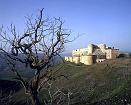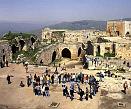| |
Krak Des Chevaliers (Qalaat Al Hosn o Qal'at Al Hisn)
The castle Krak des Chevaliers (Krak of the Knights), described by T.E. Lawrence as "perhaps the best preserved and most wholly admirable castle in the world" is the easternmost of a chain of five castles sited so as to secure the Homs Gap...It is located 65 km west of Homs in direction of Tartus, and reaches a summit of 750 meters above sea level. The castle controls a strategic passage called the Homs gap in the Orontes Valley. The castle was erected covers an area of 3 hectares and has 13 towers containing a number of halls, stores, passages, stables and bridges.
The castle stands upon a southern spur of the Gebel Alawi, it stands on a massive outcrop overlooking the plain, and incorporates the remains of an earlier castle, known as Hosn al-Akrad, the Castle of the Kurds, after the Kurdish soldiers garrisoned there in the eleventh century (it was given to a Kurdish garrison by the Amir of Aleppo in 1031). The castle that the Kurds erected was taken over by the Count of Toulouse in 1099 and then the Crusaders, commanded by Tancred of Antioch, captured it in 1110, and began a process of strengthening and enlarging the castle, until it could house a garrison of 2000. It was repeatedly attacked by the Saracens - in 1188 Saladin reportedly examined its defences and moved on without attempting to besiege it. Meanwhile, Krak passed into the keeping of the Count of Tripoli, who handed it on, in 1142, to the Knights Hospitallers (like the Templars and the Ransomers, a military religious order) from whom it took the name "des Chevaliers".
They held it for 130 years, until it was besieged and, after a month-long siege, captured by the Mameluke Sultan Beibars, on April 8th 1271.
The Krak has two concentric lines of defence, the inner ramparts lying close to the outer and continuously dominating them. The single ward of the original eleventh-century castle covered about the same area as the later inner enclosure, and some of the remains of the early work on the crest of the spur are incorporated in the existing building. The outer curtain is furnished on the north and west sides with eight round towers, of which one is later than the Crusader occupation, and of which two form the north barbican, also extended at a later date."
From the outside this fortress is intimidating in its grandeur and power. The south side of the Krak was the most vulnerable and Sultan Baybars added a strong bastion to it. The western side is quite ordinary with its curtain wall and five cylindrical towers strengthening it. The northern wing has a postern which is situated between two square shaped towers.
The defensive plan is featured by two separate lines of defence, an outer curtained wall with several cylindrical towers, and what is known as the inner ring. They are separated by a ditch except which runs around the inner ring except in the south where there is a reservoir. The inner fortress was used as the crusader castle. The entrance has a wide ramp and a vaulted passage that leads you to the outer ring and on to a platform that links to the inner castle. Large taluses were added to the southwest and east sides to strengthen the outer wall and to make it earthquake resistant. There is a small chapel to the east of the entrance that was transformed into a mosque by Baibars, and of that mosque remains a mihrab and three minbars. Opposite the chapel are three powerful towers that strengthen the south wall. The weakest of the towers was occupied by the Master (the Grand Master of the Order). There is a spiral staircase that takes you up into his room that is round and has a cross-ribbed vault,
which is supported by columns. It is linked to the bastion by a two-story lodging that is of Gothic architecture, which was being used in France at the time. There are three beautiful windows that look out from both floors. The third and most impressive of the towers is linked to the keep by a massif instead of a wall, on which many war machines would be put (Catapults, etc.). From this tower, the five-sided erection that Baibars later altered could be controlled.
There is access from here to the grand hall in the inner yard, this quite elegant construction is preceded by a portico which has seven rib-vaulted bays. This large hall of the knights included a well, a bakery, and the latrines. On the NW side is a building known as the 'Tower of the King's Daughter', the lower part of this construction dates back to the 12th century while the upper part belongs to the Arab period. From the tea room on the upper floor a beautiful view including Safita and the coast can be seen.
|
|





